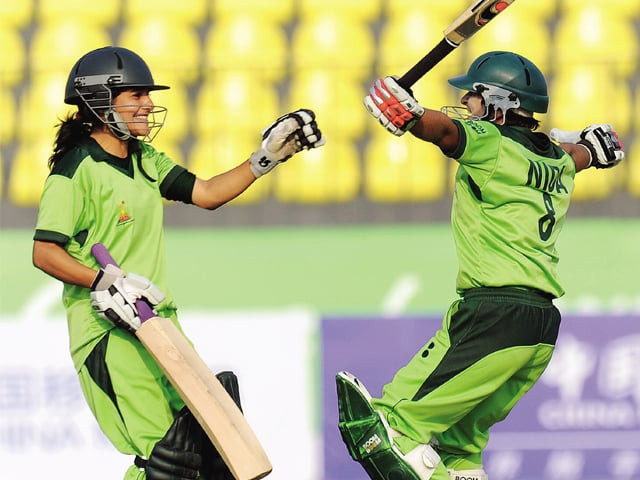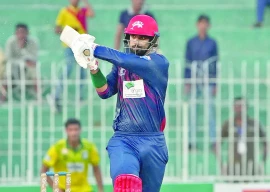
Before the cricket team’s big win at the Asian Games, women’s cricket was, at best, ignored. Now however, especially in the wake of a series of scandals that have plagued the men’s cricket team this year, Pakistanis have found new heroes in the young women who bat like they mean business.
Theirs is a story that speaks volumes about women in Pakistani society yet the charismatic players don’t see themselves as activists or
— they are athletes and they just want to compete.
“As a captain, there are two things I find extremely necessary — first, to maintain a good environment within the team and
second, not to harm the image of Pakistan. This is because at the end of the day we are representing the country,” says the current captain of the team, Sana Mir.
Cool and self possessed, the 25-year-old captain appears to be quite severe at first glance. She seems bent on maintaining a professional exterior, and despite the team’s sudden shot to glory, Sana refuses to be complacent.
“Today we are winners but tomorrow we could be losers — and no matter what, we are responsible for our country’s image,” she says.
Half an hour into our chat, however, the captain’s tough exterior melts and her softer side emerges. “I’m one of the girliest girls on the team!” she giggles. “I like dressing up! Sometimes when I meet the girls off the field I get all dressed up and they tease me.”
The hairy truth
Sana says she used to be a total tomboy until ninth grade. She describes how she slowly accepted her more feminine side and reveals that emulating men is a self-defence mechanism that some members of the team adopt.
“When I used to play outside with my brother, people would scornfully say larki khail rahi hai! So I got my hair cut short to stop the comments — it was a kind of camouflage,” says Sana.
But as she grew up she felt that being a tomboy affected girls negatively. She came to believe that it was better to embrace one’s femininity instead of fighting it. She acknowledges that there are tomboys on the squad, but says she encourages them to be true to themselves.
“I actually encourage my girls to be more girly. There are tomboys on the team because before, people didn’t like women playing cricket and with short hair you can pass off as a boy and deflect criticism. But I think with more acceptance from people, they will become more girly.”
Having a self-professed ‘girly’ as a cricketing captain may come as a shock, but other members of the team also play a similar balancing act.
The girliest girl on the team turns out to be wicket-keeper Batool Fatima. Despite playing 50 One-Day Internationals she takes an obsessive interest in her nails. A ten-day break from cricket would see this well-dressed team member sporting long, well-groomed nails. The downside is that she has to have them clipped before a game to adhere to the team rules.
At the other end of the spectrum is Nida Dar, who took three wickets and scored 51 runs to help Pakistan dismiss Bangladesh for a mere 92 in 20 overs in the Asian Game’s final match. Nida is warm and bubbly and according to Sana, this star player and Saniya Iqbal are the least girly of the bunch.
When asked about the prospect of marriage and how it was impacted by being part of the women’s cricket team, the all-rounder brushed aside all possibilities for that commitment at present and joked: “Five years of practicing hard balls has made these hands rough, it will take at least two years to make them soft again. So marriage is out of the question for now.”
Love-struck fans
“I’m extremely strict so people are too scared to flirt with me or say anything to me. But there are some girls who have love-struck fans,” says Sana.
She pauses for a second, chuckles and continues: “Like in Bangladesh, the crowd used to go absolutely insane when Asmavia Iqbal or Qanita Jaleel used to step on the field. We still bug them about it.”
The players on the team, however, aren’t taken with any athletes in Pakistan — most of their attentions are focused abroad. “The girls are more into international players like Andy Roddick,” says Sana. “Roger Federer is one of my favourites actually, but he’s married — so I can’t talk about him much.”
As far as men go, Nida Dar now believes the Asian Games win has brought the players more respect than their male counterparts. “I think people see us as number one now. Look at what we’ve accomplished — a gold after eight years. Men have acknowledged our accomplishments and say ‘At least you’re better than the male players!’ And women think many doors have opened for them because of us.”
You can sense the pride in Nida’s voice as she speaks. Despite joining the team a little under a year ago, she doesn’t hesitate in saying that she thinks of herself as one of the most important players in the team. “I was the player of the match in the final and I made the team win. Opener Javeria Wudood and I were the only two scorers of the team in the final but overall we didn’t give anyone on the team any chances because of our performance.”
“I’m one of the happiest members of the team and I’m absolutely grateful for everything, and all the experiences I’ve had,” says Nida.
Sana Gulzar, however, is one of the Pakistan’s cricketers who always brings a smile to the team. “She’s one girl who is happy all the time and keeps others happy as well,” says the captain.
Not all smooth sailing
Dressing room problems seem to be at a minimum, with the team demonstrating immense respect for their captain. Nida dismisses the prospect of ever becoming captain. “Captain? Never, even if I was offered. I like our captain and vice captain and it’s only because of them that I’m here.”
Despite their carefree demeanour, though, the girls each have their own unique story to tell about the obstacles they have had to overcome to become cricketers.
Nida hails from Gujranwala, where a dearth of cricket facilities for women plus the social stigma associated with women playing sports were her biggest obstacles. Even though she has her family’s full support now, she claims that her brother was her biggest critic when she initially attempted to pursue cricket as her profession.
“My brother’s friends used to ask him, ‘Is that your sister playing outside?’ and I get it — in our socitey’s context, it looks bad.”
Cricketers from places other than Karachi or Lahore face a lot of problems, including a lack of support from their families, as well as having no place to practice due to lack of facilities. However, they are so committed that they either live away from home or travel to these metropolitan cities on a regular basis just to maintain their form.
Sana is one of the few privileged girls on the team who came from Lahore and hence had access to proper sports facilities. Her elder brother Humayun was her first coach and she used to play with him. After spending countless hours observing and playing cricket with boys older than her she finally started to master her skills. “All the girls I knew used to watch movies and stay indoors but I used to play outdoors. I used to play whatever sports were available.”
But she did struggle, although in a different way, when she sustained a stress fracture in her back in 2006 — 2007. “I used to be a fast bowler. A lot of doctors said that I shouldn’t play because I could get paralysed. So I switched over to spin bowling. It was tough for me because I wanted to bowl fast. But I’ve come a long way and now I’m in the top twenty in spin.”
Playing with boys
Nida points out that playing cricket with boys could really help the team’s performance. Being the daughter of Khawaja Rashid Hassan, a former first class player, she feels that she received a lot of support.
“Many families have problems with girls playing boys but my dad has been a first class player so he realised you get more practice with boys.”
She adds, “The team members don’t have any problems playing against boys because this will help us improve. Actually, the boys think we’re boys and we think they’re girls.”
At one point, she compares the situation in Pakistan with women’s cricket teams from England and Australia, and says that foreign teams practice so much more that she was shocked. “They don’t even look like girls — they look like boys because they are playing all the time,” she says.
Money issues
“Girls don’t get money,” Nida admits. “The country thinks that it’s all about the boys and that girls can’t do anything. But thankfully for our cricket team, now we don’t face this problem unlike other atheletes,” says Nida, comparing other Pakistani female athletes with the female cricket team.
“Our residence is like a seven star hotel. We stay at the Lahore country club where there are swimming pools, we can play table tennis, badminton, and the rooms have everything,” she says.
Nida acknowledges that more sponsors are needed and that although some girls had jobs, the ones who were not employed were facing financial difficulties. “We don’t get match fees, but we have dailies. But that’s Rs500 and that’s not enough.”
Bitter aftertaste
Recalling more difficult times, former team member Kiran Baluch admits that “we faced death threats from political parties who couldn’t digest the idea of men playing with women.”
“If a net cost Rs500, people would try to sell it to us for Rs 2,500 to stop us playing.”
“At one point, we were preparing for a camp in Lahore we were hoping the PCB would help us. But instead our cricket sessions were held in a parking garage. PCB refused to give us a cricket coach so we had to fly an Australian coach, Jodie Davis, out here for one and a half months,” Kiran says.
“The girls who join cricket now are getting it on a silver platter,” says Kiran. “It’s only after the PCB started getting money that they started paying attention to women’s cricket.”
After shattering the world record for Test highest score against the West Indies in 2004, Kiran rues the fact that the Melbourne Cricket Club lauded them, but the PCB didn’t.
“Why were we never honoured? Just give us a medal worth Rs10. Instead they say they don’t acknowledge our world records,” Kiran says.
At the end of the day, the cricketers acknowledge that women’s cricket may be making strides, but it still has a long way to go.
“When people didn’t know us, they used to tell us to give up cricket,” says Nida. “But when we got more attention in the media people began to praise us. And now, no one asks us to give up the game.”
A brief history of women’s cricket in Pakistan
Women’s cricket was formally introduced to Pakistan in the 1990s when sisters Shaiza and Sharmeen Khan organised the sport, using their own finances to fund team members’ tickets abroad for matches as they toured Sri Lanka, England and Ireland. The sisters also formed the Pakistan Women’s Cricket Control Association (PWCCA).
Shaiza served as team captain for some time and took 13 wickets, including a hat-trick, during her stint. Kiran Baluch, who served as vice captain in 2004 for the longer format of the game, made 242 runs in a Test match against the West Indies in Karachi, creating a world record that still stands.
In 2005, things got messy when the International Cricket Council (ICC) merged with the International Women’s Cricket Council and all the cricket boards of the playing countries were asked to set up their own women’s wing. Instead of the Pakistan Cricket Board (PCB) merging with Pakistan Women’s Cricket Control Association, the board had a new body instituted in its place. Today there is still a case against the PCB by the PWCCA, with the women’s body claiming that an illegal body replaced them.
Published in The Express Tribune, December 19th, 2010.


















COMMENTS
Comments are moderated and generally will be posted if they are on-topic and not abusive.
For more information, please see our Comments FAQ